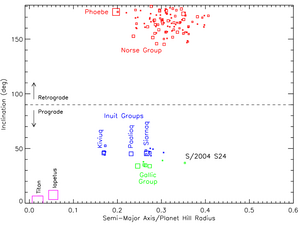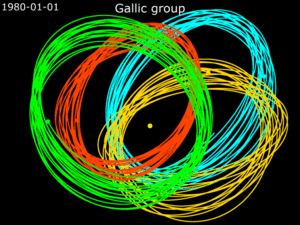Astronomy:Gallic group

The Gallic group is a dynamical grouping of the prograde irregular satellites of Saturn following similar orbits. Their semi-major axes range between 16 and 19 Gm, their inclinations between 36° and 41°, and their eccentricities between 0.46 and 0.53. The International Astronomical Union (IAU) reserves names taken from Gallic mythology for these moons.
Similar mean orbital elements led the discoverers to postulate a common origin for the group in a breakup of a larger body.[1] The group was later found to be physically homogeneous, all satellites displaying light-red colour (colour indices B − V = 0.91 and V − R = 0.48)[2] and similar infrared indices.[3]
Remarkably, recent observations revealed that the largest member of the group, Albiorix, actually displays two different colours: one compatible with Erriapus and Tarvos, and another less red. Instead of the common progenitor, it was postulated that Tarvos and Erriapus could be fragments of Albiorix, leaving a large, less red crater.[4] Such an impact would require a body with the diameter in excess of 1 km and relative velocity close to 5 km/s, resulting in a large crater with the radius of 12 km. Numerous, very large craters observed on Phoebe, prove the existence of such collisions in the Saturnian system's past.
The discovery of 20 new moons of Saturn was announced in October 2019 by a team led by Scott S. Sheppard using the Subaru Telescope at Mauna Kea. One of them, S/2004 S 24, is also prograde and of similar inclination, but it orbits much further away from Saturn than the other Gallic moons. This moon will nevertheless also receive a name from Gallic mythology.[5]
The members of the group are (in order of increasing distance from Saturn according to JPL mean orbital elements):[6]
| Name | Diameter (km) | Period (days) |
|---|---|---|
| Albiorix | 28.6 | 783.49 |
| Bebhionn | 7 | 834.94 |
| S/2007 S 8 | 4 | 836.90 |
| S/2004 S 29 | 5 | 837.78 |
| Erriapus | 12 | 871.10 |
| Tarvos | 16 | 926.37 |
| S/2020 S 4 | 3 | 926.92 |
| S/2006 S 12 | 4 | 1035.05 |
| S/2019 S 6[lower-alpha 1] | 4 | 1066.40 |
| S/2004 S 24 | 3 | 1341.33 |
See also
Notes
- ↑ JPL's mean orbital elements suggest an inclination that is similar to those of the Gallic group; however other sources say it belongs to the Inuit group.
References
- ↑ Gladman, B. J. et al. (2001). "Discovery of 12 satellites of Saturn exhibiting orbital clustering". Nature 412 (6843): 163–6. doi:10.1038/35084032. PMID 11449267.
- ↑ Grav, Tommy; Holman, Matthew J.; Gladman, Brett J.; Aksnes, Kaare (2003). "Photometric survey of the irregular satellites". Icarus 166 (1): 33–45. doi:10.1016/j.icarus.2003.07.005. Bibcode: 2003Icar..166...33G.
- ↑ Grav, Tommy; Holman, Matthew J (2004). "Near-Infrared Photometry of the Irregular Satellites of Jupiter and Saturn". The Astrophysical Journal 605 (2): L141–L144. doi:10.1086/420881. Bibcode: 2004ApJ...605L.141G.
- ↑ Grav, T.; Bauer, J. (2007-11-01). "A deeper look at the colors of the Saturnian irregular satellites". Icarus 191 (1): 267–285. doi:10.1016/j.icarus.2007.04.020. http://arxiv.org/abs/astro-ph/0611590.
- ↑ NASA (October 7, 2019). "Saturn surpasses Jupiter after the discovery of 20 new moons—and you can help name them" (in en). https://phys.org/news/2019-10-saturn-surpasses-kupiter-discovery-moonsand.html.
- ↑ "Planetary Satellite Mean Orbital Parameters". Jet Propulsion Laboratory. https://ssd.jpl.nasa.gov/sats/elem/sep.html.
External links
 |


